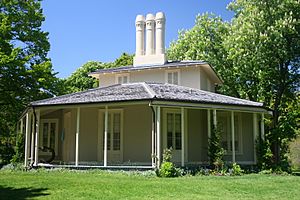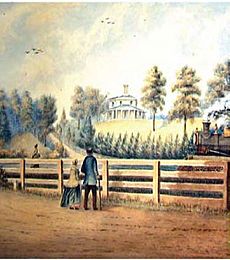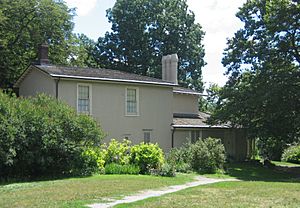Colborne Lodge facts for kids

Colborne Lodge in 2009
|
|
| Established | 1928 |
|---|---|
| Location | Toronto, Ontario, Canada |
| Type | Historic house museum |
Colborne Lodge is a special old house in Toronto's High Park. It was built in 1837 and is now a historic house museum. An architect and engineer named John George Howard built this home. He was a very important person in Toronto. After he passed away in 1890, the house became the property of the city.
Contents
History of Colborne Lodge
John George Howard designed and built Colborne Lodge between 1836 and 1837. He built it for himself and his wife, Jemima Frances Meikle. The house sits on top of a hill and looks out over Lake Ontario.
What Kind of House Is It?
Colborne Lodge is a great example of the Regency picturesque cottage style. This means it was designed to look like it fit right into the beautiful nature around it. This was different from other houses at the time, which were often very formal.
When it was first built, the house had only one floor. It was like a country cottage for the Howards. In the 1850s, they moved in full-time and made it bigger. They added a basement and an upper floor. They also added more rooms. One cool addition was an indoor flush toilet! This was the first one of its kind that still exists in Toronto.
Who Was Colborne Lodge Named After?
The house got its name from Sir John Colborne. He was the Lieutenant-Governor of Upper Canada from 1828 to 1836. He was also the first person to support John Howard's architecture. Next to the house, you can still see the Colborne Lodge gardens. The Howards created these gardens themselves.
The Land Around the Lodge
The cottage was built on a large piece of land, about 165 acres. This land stretched from Bloor Street all the way to Lake Ontario. It covered about one-third of what is now High Park. The Howards later bought a smaller piece of land near the lake.
When they moved into the Lodge full-time, John and Jemima Howard started a small farm. They had farm cottages, a place for dairy, a chicken house, and gardens for growing food. John Howard tried to sell parts of his land to create a new neighborhood. But it didn't work out. The area was quite far from Toronto back then. It was also hard to build on because of the hills, wet areas, and sandy soil.
The Howards' Legacy
John and Jemima Howard did not have any children. In 1873, they gave all their land and buildings to the City of Toronto. In return, the city gave them money for the rest of their lives. John continued to live in the house until he passed away in 1890.
The city bought more land nearby in 1876 and 1930. This made High Park much bigger, to its current size of about 399 acres.
John and Jemima Howard are buried under a stone monument called the Howard Tomb. It is across Colborne Lodge Drive and looks out over Grenadier Pond. John Howard designed the monument himself. The fence around the tomb is very old and special. It came from St Paul's Cathedral in London, England. A famous architect named Christopher Wren designed it in 1714. John Howard had it shipped from London in 1875.
After John Howard passed away in 1890, the Stinson family lived in the house until 1913. They were part of John Howard's household staff.
Colborne Lodge as a Museum
After being empty for a while, Colborne Lodge was fixed up. It opened as a museum in 1928. The Women's Canadian Historical Society helped make this happen.
Today, Colborne Lodge is a historic house museum run by the City of Toronto. The museum includes the house, its gardens, and the old coach house. Inside, you can see how people lived in the 1800s. Many of the furniture pieces, belongings, and artworks belonged to the Howards themselves. You can also see some of John Howard's original architectural designs.
The museum hosts fun events all year long. For example, there are activities during the High Park cherry blossom season. They also have special events during the winter holidays. Kids can even attend summer camps there! Around Halloween, guides give "ghost tours" where they talk about spooky stories and legends connected to the Lodge.
See also



